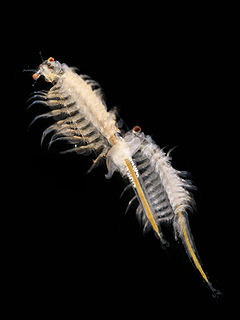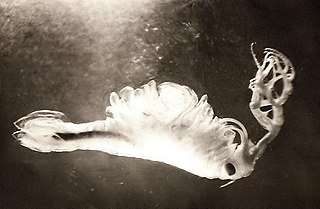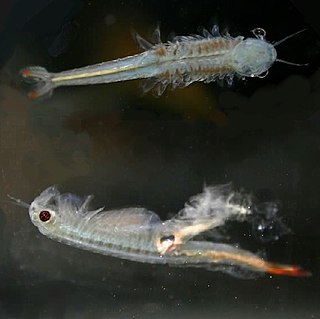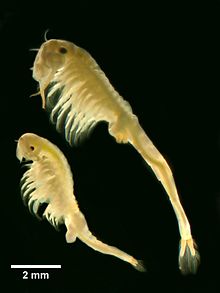
Branchiopoda is a class of crustaceans. It comprises fairy shrimp, clam shrimp, Cladocera, Notostraca and the Devonian Lepidocaris. They are mostly small, freshwater animals that feed on plankton and detritus.

The Caridea, commonly known as caridean shrimp or true shrimp, are an infraorder of shrimp within the order Decapoda. This infraorder contains all species of true shrimp. They are found widely around the world in both fresh and salt water. Many other animals with similar names – such as ghost shrimps, mud shrimps, and boxer shrimps – are not true shrimps, but many have evolved features similar to true shrimps.

Artemia is a genus of aquatic crustaceans also known as brine shrimp. Artemia, the only genus in the family Artemiidae. The first historical record of the existence of Artemia dates back to the first half of the 10th century AD from Urmia Lake, Iran, with an example called by an Iranian geographer an "aquatic dog", although the first unambiguous record is the report and drawings made by Schlösser in 1757 of animals from Lymington, England. Artemia populations are found worldwide in inland saltwater lakes, but not in oceans. Artemia are able to avoid cohabiting with most types of predators, such as fish, by their ability to live in waters of very high salinity.

Anostraca is one of the four orders of crustaceans in the class Branchiopoda; its members are also known as fairy shrimp. They live in vernal pools and hypersaline lakes across the world, and they have even been found in deserts, ice-covered mountain lakes and Antarctic ice. They are usually 6–25 mm (0.24–0.98 in) long. Most species have 20 body segments, bearing 11 pairs of leaf-like phyllopodia, and the body lacks a carapace. They swim "upside-down" and feed by filtering organic particles from the water or by scraping algae from surfaces. They are an important food for many birds and fish, and some are cultured and harvested for use as fish food. There are 300 species spread across 8 families.

Branchinecta is a genus of crustacean in family Branchinectidae. It includes around 50 species, found on all continents except Africa and Australia. Branchinecta gigas, the giant fairy shrimp, is the largest species in the order, with a length of up to 10 centimetres (4 in), and Branchinecta brushi lives at the highest altitude of any crustacean, at 5,930 metres (19,460 ft), a record it shares with the copepod Boeckella palustris. A new genus, Archaebranchinecta was established in 2011 for two species previously placed in Branchinecta.

Branchinella is a genus of crustaceans in the family Thamnocephalidae. This fairy shrimp genus is found across many parts of the world, but especially western Australia and southern Africa.
Branchinella apophysata is a species of crustacean in the family Thamnocephalidae. It is endemic to Australia, where it is known only from its type locality, a shallow pool on Mount Margaret, near Laverton, Western Australia. It is most closely related to other Australian species, including B. affinis, B. denticulata, B. latzi, B. longirostris and B. probiscida.

Chirocephalus is a genus of fairy shrimp in the family Chirocephalidae. It contains the following species:
Eoleptestheria ticinensis is a species of clam shrimp in the family Leptestheriidae. Although up to eight species have formerly been recognised in the genus Eoleptestheria, they are more usually all considered part of one species with a cosmopolitan distribution.
Eucrenonaspides oinotheke is a species of crustacean in the family Psammaspidae, endemic to Tasmania, the only species described in the genus Eucrenonaspides. It was described from a spring at 9 Payton Place, Devonport, Tasmania in 1980, making it "the first spring-dwelling syncarid recorded from the Australian region". It is listed as a vulnerable species on the IUCN Red List. A further undescribed species is known from south-western Tasmania.
Parartemia contracta is a species of fairy shrimp in the family Parartemiidae and is commonly found in Australia.

Streptocephalus is a genus of fairy shrimp found in temporary waters in Africa, Australia, Eurasia, and Central and North America, following its ancient origin in Gondwana. It contains the following species:

Artemia salina is a species of brine shrimp – aquatic crustaceans that are more closely related to Triops and cladocerans than to true shrimp. It belongs to a lineage that does not appear to have changed much in 100 million years.

Thamnocephalidae is a family of crustaceans with wide distribution including Western Australia, Southern Africa and South America. It was originally described as a subfamily of Branchipodidae by Alpheus Spring Packard in 1883, and elevated to the rank of family by Simon in 1886. Six genera are recognised, in two subfamilies:
Lebbeus clarehannah is a species of shrimp discovered in 2005 off the southwest coast of Western Australia. Former NBA player Luc Longley won the rights to name the shrimp in an eBay auction. He named the shrimp after his daughter, Clare Hanna Longley, as a birthday present to her.
Branchinecta gigas is a species of fairy shrimp that lives in western Canada and the United States. It is the largest species of fairy shrimp, growing up to 86 mm (3.4 in) long. It is known commonly as the giant fairy shrimp.

Dendrocephalus is a genus of fairy shrimp found in South and North America. It is characterised by the presence of an antenna-like appendage arising between the second antennae and the eyestalks. The genus comprises 16 species in two subgenera:
Parastreptocephalus is a subgenus of the fairy shrimp genus Streptocephalus, characterised by features of the male antennae and the tetrahedral shape of the eggs. It comprises six species:

Artemia parthenogenetica is a species of brine shrimp – aquatic crustaceans belonging to a different class, the Branchiopoda, than the true shrimps.












